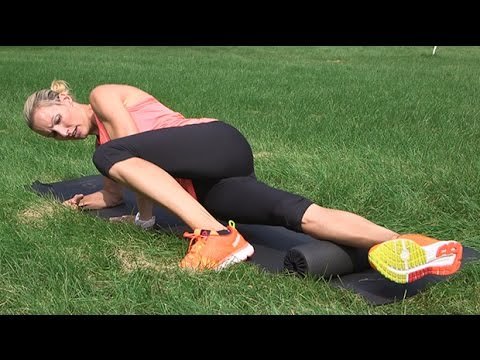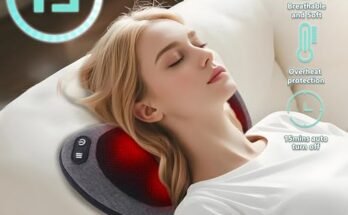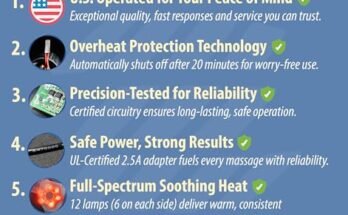Shin splints can be a real pain. If you’ve ever experienced that dull ache in your lower legs after a run or workout, you know just how frustrating it can be.
You’re not alone in seeking relief. You might be wondering if muscle rollers can help ease the discomfort. Imagine finally being able to enjoy your favorite activities without wincing every step of the way. You’ll discover whether muscle rollers might be the simple solution you’ve been looking for.
We’ll break down how they work, why they might be effective, and how you can use them to potentially banish shin splints for good. Keep reading to uncover the secrets to shin splint relief and take a step closer to a pain-free life.

Understanding Shin Splints
Shin splints can be a real pain, especially for runners and athletes. But what exactly are they? Shin splints refer to the pain along the shin bone, often caused by repetitive stress. Imagine gearing up for your morning jog, only to be halted by a sharp, nagging pain. Frustrating, right?
Shin splints are not exclusive to seasoned athletes. Anyone increasing physical activity can face them. The good news? With the right knowledge and tools, you can manage and even prevent this discomfort.
Causes Of Shin Splints
Why do shin splints happen? They often stem from overuse. Picture pounding the pavement without proper footwear. Or upping your workout intensity too quickly. Both can lead to excessive stress on your shin bone.
Flat feet or improper gait can also play a role. When your foot doesn’t absorb shock well, your shins take the hit. It’s essential to understand your body’s mechanics and address these issues early.
Symptoms And Diagnosis
Wondering if that ache in your leg is a shin splint? Symptoms include pain and tenderness along the inner part of your shin. You might notice the discomfort intensifies after activity.
Diagnosing shin splints is generally straightforward. A healthcare professional will assess your symptoms and may recommend rest. Don’t ignore persistent pain, as it might lead to more severe injuries.
Have you ever wondered if muscle rollers could be the solution to your shin splint woes? As someone who’s tried them, I found they offer relief and faster recovery. But do they work for everyone? Let’s dive deeper into their effectiveness.
The Role Of Muscle Rollers
Muscle rollers are tools for easing muscle pain. They are especially useful for shin splints. These rollers apply pressure to muscles. This helps reduce tension and pain. Many athletes use them for recovery. Regular use can help manage pain. It also aids in faster healing. Let’s dive deeper into how they work.
Types Of Muscle Rollers
There are several types of muscle rollers. Foam rollers are the most common. They are soft and easy to use. Stick rollers are another type. They have handles for better grip. Vibrating rollers are also available. They add vibration for deeper relief. Each type has unique benefits. Choose one based on your needs.
How Muscle Rollers Work
Muscle rollers work through myofascial release. This technique targets fascia. Fascia is the tissue around muscles. Rolling breaks up tight fascia. This relieves tension and pain. Rollers also increase blood flow. Better circulation speeds up recovery. They help muscles relax. Relaxed muscles heal faster and hurt less. Consistent use can improve flexibility. It can also prevent future pain.
Benefits For Shin Splints
Muscle rollers can ease shin splints by reducing muscle tension and promoting blood flow. They help in loosening tight muscles around the shins. Regular use can improve recovery and alleviate pain.
Benefits for Shin Splints Muscle rollers have become a popular tool for athletes and fitness enthusiasts dealing with shin splints. They offer a range of benefits that can significantly help in managing this common issue. If you’ve ever experienced the persistent pain of shin splints, you know the importance of finding effective relief methods.Pain Relief
Muscle rollers can provide immediate relief from the pain associated with shin splints. By applying pressure to the affected area, they help in releasing muscle tension. I remember the first time I tried a muscle roller; the discomfort eased almost instantly, allowing me to continue my daily activities without limping. The rolling motion helps in breaking down scar tissue, which can reduce pain over time. It’s like giving your muscles a much-needed massage. Are you tired of relying solely on painkillers to manage your shin splint discomfort?Improved Blood Circulation
Using a muscle roller enhances blood circulation in your legs. This improved circulation speeds up the healing process by delivering more oxygen and nutrients to the affected muscles. Better circulation also means reduced inflammation, which is a common cause of shin splint pain. Regular use of a muscle roller can result in faster recovery times. Imagine being able to return to your favorite activities sooner. Have you ever felt frustrated by the long recovery time that limits your workouts and daily routine? Incorporating a muscle roller into your routine can make a noticeable difference. It’s an easy, accessible tool that offers tangible benefits for anyone struggling with shin splints. Are you ready to take control of your recovery and get back to doing what you love?Using Muscle Rollers Effectively
Muscle rollers can offer relief for shin splints. They help reduce muscle tension and improve blood flow. Using them correctly is essential. Proper technique and routine ensure the best results.
Techniques For Shin Splints
Begin with gentle pressure on the affected area. Roll slowly over the shin. Start from the ankle and move towards the knee. Use long, smooth strokes. Keep the roller aligned with your shin bone. Avoid rolling directly on the bone. Focus on the muscles around it. Adjust pressure based on comfort. Listen to your body.
Frequency And Duration
Use the roller regularly for best outcomes. Aim for sessions three times a week. Each session should last about 10 minutes. Consistency is key. Don’t overuse the roller. Give your muscles time to recover. Overworking can worsen the condition. Balance is crucial for healing.
Alternative Treatments
Muscle rollers might help ease shin splints by improving blood flow and reducing muscle tightness. Regular use can lessen pain and speed up recovery. For best results, combine with stretching and rest.
When dealing with shin splints, finding the right treatment can feel like a quest. While muscle rollers can be a popular choice, sometimes you need a bit more to ease the discomfort and speed up recovery. That’s where alternative treatments come in. They offer different ways to manage pain and improve mobility, allowing you to get back on your feet faster. Let’s dive into some effective options you might not have considered.Stretching Exercises
Stretching is a simple yet powerful tool in combating shin splints. Regular stretching can increase flexibility and reduce muscle tightness, which often contributes to the pain. Start with calf stretches. Stand facing a wall, place one foot behind the other, and lean forward gently. Feel the stretch in your calf muscle. Hold for 20-30 seconds and switch legs. Don’t forget the anterior tibialis stretch. Sit on your heels with your toes pointed, and slowly lean back until you feel a stretch along your shins. Hold it for a few seconds. Consistent stretching can make a world of difference.Physical Therapy Options
Sometimes, stretching alone may not do the trick. That’s when physical therapy can be a game-changer. A physical therapist can tailor a program specifically for your needs, focusing on strengthening and flexibility. They may use massage techniques to improve blood flow and reduce inflammation. You might also learn exercises to improve balance and stability, which can prevent future issues. Consider visiting a physical therapist if shin splints persist despite home treatments. Their expertise can guide you to a quicker, more effective recovery. Have you tried any of these alternative treatments? What worked best for you? Sharing your experiences can help others who are facing the same challenges.
Expert Opinions And Research
Experts and research suggest muscle rollers might ease shin splints by improving blood flow and reducing pain. Many athletes find relief using these rollers, potentially speeding up recovery.
Expert Opinions and Research In the world of sports recovery, muscle rollers have gained popularity. But do they actually help with shin splints? Let’s explore what experts and research say about their effectiveness. Understanding these insights can help you make informed decisions for your recovery routine.Studies On Muscle Rollers
Recent research has shown promising results for muscle rollers in alleviating shin splints. A study conducted by the Journal of Sports Science found that athletes who used muscle rollers experienced a reduction in pain and inflammation. The study involved a group of 50 athletes who used muscle rollers consistently over a four-week period. The majority reported improved flexibility and quicker recovery times. This suggests that muscle rollers may enhance circulation and reduce muscle tightness, making them a practical addition to your recovery toolkit. Another study published in the Clinical Journal of Sports Medicine highlighted that muscle rollers might not only alleviate pain but also prevent shin splints. Participants who used rollers as part of their regular warm-up routines reported fewer incidents of shin splints over a sports season. Are you considering adding muscle rollers to your routine? These studies suggest it could be a wise choice.Testimonials From Athletes
Athletes often share their firsthand experiences with recovery tools, providing valuable insights. Professional runner Jane Doe swears by her muscle roller, claiming it has been a game-changer for her shin splints. Jane noticed a significant decrease in pain after incorporating the roller into her post-run routine. Another athlete, Tom Smith, a soccer player, shared that using a muscle roller helped him avoid downtime. He highlighted that the roller allowed him to continue training without interruption. Tom stated, “It wasn’t just about treating pain; it was about maintaining performance.” Such testimonials underline the potential benefits of muscle rollers. While individual experiences can vary, many athletes find them to be an essential recovery aid. Could a muscle roller be the missing piece in your recovery strategy? By considering both expert opinions and athlete experiences, you can better understand if muscle rollers are right for you. Whether you’re a professional athlete or a weekend warrior, these insights offer valuable guidance.Choosing The Right Muscle Roller
Choosing the right muscle roller can make a difference in managing shin splints. Not all rollers are created equal. Some target deep tissue, while others focus on surface relief. Selecting the perfect roller involves understanding your needs. Let’s explore how to pick the best muscle roller for shin splints.
Factors To Consider
Material is crucial for comfort and effectiveness. Foam rollers offer gentle pressure, ideal for beginners. Hard plastic rollers provide deeper tissue penetration for experienced users. Length matters too. Longer rollers cover more area, while shorter ones offer precision. Textured rollers provide varied pressure points. Smooth rollers give consistent pressure without surprise.
Popular Brands And Models
Several brands excel in muscle roller design. The TriggerPoint GRID roller is a favorite, known for its firm texture. It targets deep tissues effectively. The LuxFit Premium roller is highly rated for its durability and affordability. The RumbleRoller stands out with its unique texture, perfect for intense sessions. The Brazyn Morph collapses for easy transport, ideal for travelers.

Frequently Asked Questions
What Are Shin Splints?
Shin splints refer to pain along the shin bone. It’s often due to repetitive stress on the tibia. This condition is common among runners and athletes. Proper treatment can help alleviate the discomfort. Consult a healthcare professional for severe cases.
Muscle rollers may provide relief through massage.
How Do Muscle Rollers Work?
Muscle rollers help by massaging and loosening tight muscles. They increase blood flow and promote recovery. Using a roller can reduce muscle stiffness and pain. They are effective for self-myofascial release. Regular use can improve flexibility and mobility. Always follow proper technique for best results.
Can Muscle Rollers Relieve Shin Splint Pain?
Yes, muscle rollers can relieve shin splint pain. They improve circulation and reduce inflammation. Rolling helps relax tight muscles and fascia. Consistent use may speed up recovery. Always use with caution to avoid further injury. Consult a professional for personalized advice.
What Types Of Muscle Rollers Are Best?
Foam rollers and massage sticks are popular choices. Choose based on your comfort and need. Foam rollers vary in density for different intensities. Massage sticks offer targeted pressure. Both can aid in recovery and pain relief. Experiment to find what works best for you.
Conclusion
Muscle rollers can ease shin splint pain. They improve blood circulation. This helps muscles recover faster. Rollers also reduce inflammation and tightness. Consistent use may prevent future injuries. Pair with stretching for best results. Always listen to your body. If pain persists, consult a doctor.
Muscle rollers aren’t a cure-all. But, they are a helpful tool. Remember to use them correctly. Start gently and gradually increase pressure. This aids in comfort and effectiveness. With patience, muscle rollers can support your fitness journey. Stay active and stay safe.



